Monthly Archives: December 2022


 My grandniece, Izabella Harman has a personality that far exceeds her small stature. She is full of smiles and always happy. Her mom, Melanie Harman, says that she is growing into her personality, but I think that such a big personality will take a little time to for her to grow that much. Izabella “Belle” has such a bubbly personality, and that is pretty hard to contain.
My grandniece, Izabella Harman has a personality that far exceeds her small stature. She is full of smiles and always happy. Her mom, Melanie Harman, says that she is growing into her personality, but I think that such a big personality will take a little time to for her to grow that much. Izabella “Belle” has such a bubbly personality, and that is pretty hard to contain.
Belle is so very sweet. As she has grown, she has become rather protective of her mom. She doesn’t want her to work too hard. So, Belle has designated herself as “Momma’s Helper.” She makes sure that Melanie doesn’t  carry too many things at once. If Melanie has a large load of stuff she is carrying, Belle says “No, no Momma!! You have too much stuff!! Give me that!!” Being a helper is one of her top priorities, and while he mom is her top priority, she doesn’t limit herself to helping just her mom. Her teacher says she is so very sweet and helpful with other kids in class. She loves doing her schoolwork, which isn’t always a common thing. In fact, she loves it so much that she gets irritated when other kids around her are distracting her from doing her work. It is rare to see such a dedicated student, but then, Belle isn’t just your average student.
carry too many things at once. If Melanie has a large load of stuff she is carrying, Belle says “No, no Momma!! You have too much stuff!! Give me that!!” Being a helper is one of her top priorities, and while he mom is her top priority, she doesn’t limit herself to helping just her mom. Her teacher says she is so very sweet and helpful with other kids in class. She loves doing her schoolwork, which isn’t always a common thing. In fact, she loves it so much that she gets irritated when other kids around her are distracting her from doing her work. It is rare to see such a dedicated student, but then, Belle isn’t just your average student.
Bell loves her siblings, and she is so sweet to Alice and Jaxx. She loves being around them. Belle has never stopped being a Daddy’s Girl though!! Her daddy, Jake Harman is her hero!! When she wants him, she squeals, “Daddy, Daddy, Daddy, Daddy!!” What dad wouldn’t just melt when his girl does that. She tells him in no uncertain terms that he is the greatest dad ever.
Belle has been taking Karate, and her Sensei is always telling her aunt, Siara Kirk just how awesome Belle is. While Belle is becoming a “lethal weapon,” she is also the most loving girl. She loves having “Girls’ Days” with her Aunt Siara and her grandma, Chantel Balcerzak. Sometimes they just hang out, and sometimes they 

 workout. She also loves playing video games with her grandpa, Dave Balcerzak too. She is the light of their lives. On a funny note, Belle likes to say “Yo and Bro” a lot and her Aunt Siara thinks that’s so funny. Her family is so important to her, and that makes her a very special girl. Today is Belle’s 7th birthday. Happy birthday Belle!! Have a great day!! We love you!!
workout. She also loves playing video games with her grandpa, Dave Balcerzak too. She is the light of their lives. On a funny note, Belle likes to say “Yo and Bro” a lot and her Aunt Siara thinks that’s so funny. Her family is so important to her, and that makes her a very special girl. Today is Belle’s 7th birthday. Happy birthday Belle!! Have a great day!! We love you!!

 The years rush by so very fast, especially in the lives of children. It is really hard for me to believe that my grandnephew, Isaac Spethman is so grown up now, but somehow, he went from being a little teeny kid to the almost full grown 16-year-old he is today. Isaac is the third child of my niece Jenny Spethman and her husband Steve, and he has been a great blessing to them. As a little kid, Isaac was so unique. He decided at a young age that he needed a job, and even talked the neighborhood grocery store into “hiring” him to do little odd jobs, for which they “paid” him in things like candy bars and such. It was a win-win situation for both of
The years rush by so very fast, especially in the lives of children. It is really hard for me to believe that my grandnephew, Isaac Spethman is so grown up now, but somehow, he went from being a little teeny kid to the almost full grown 16-year-old he is today. Isaac is the third child of my niece Jenny Spethman and her husband Steve, and he has been a great blessing to them. As a little kid, Isaac was so unique. He decided at a young age that he needed a job, and even talked the neighborhood grocery store into “hiring” him to do little odd jobs, for which they “paid” him in things like candy bars and such. It was a win-win situation for both of  them. The store loved seeing this little boy with an adult work ethic, so eager to start his working career, and Isaac loved being a “big” kid with a job.
them. The store loved seeing this little boy with an adult work ethic, so eager to start his working career, and Isaac loved being a “big” kid with a job.
Isaac’s work ethic has not changed over the years. He really has never been without some kind of a job, working for actual pay well before the normal age to be hired, but of course, within the legal allowances by getting a work permit when necessary. Even when he was too young to work in a business, he was out raking laws, shoveling snow, and such to earn a little bit here and there. Most recently, he has been working at Hardee’s and has been one of their most loyal workers. I don’t suppose he will stay in the fast-food industry forever, but it has been a good start. The biggest drawback to that has been that someone has to take him to work and bring him home. However, that problem is about to go away.
Now that Isaac is 16 years old, the next obvious step is to get his driver’s license. Im not sure when he will go 
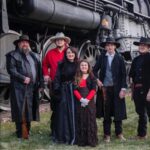 for that, considering the current weather in our fair city, but I doubt it will be very long. Isaac, like most kids as they reach 16 years tend to start pushing their parents to take them in for their test. And the reality is that most parents, especially those who have long been the chauffer, are very, very ready to take their kids for that test. Isaac is a kid who has always shown a little more maturity than the average kid, and it really has been a pleasure watching him grow up. He is a good big and little brother, as well as a loving son. We are all very proud of him. Today is Isaac’s 16th birthday. Happy birthday Isaac!! Have a great day!! We love you!!
for that, considering the current weather in our fair city, but I doubt it will be very long. Isaac, like most kids as they reach 16 years tend to start pushing their parents to take them in for their test. And the reality is that most parents, especially those who have long been the chauffer, are very, very ready to take their kids for that test. Isaac is a kid who has always shown a little more maturity than the average kid, and it really has been a pleasure watching him grow up. He is a good big and little brother, as well as a loving son. We are all very proud of him. Today is Isaac’s 16th birthday. Happy birthday Isaac!! Have a great day!! We love you!!
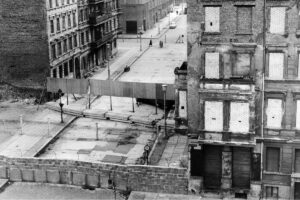
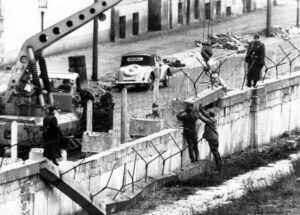 In August of 1961, virtually overnight, the Berlin appeared, separating East and West Berliners from each other. Streets, subway lines, bus lines, tramlines, canals, and rivers were divided. Family members, friends, lovers, schoolmates, work colleagues, and others were abruptly separated. For many, life was put on hold. That meant that families were instantly separated from each other, and there was nothing anyone could do about it. If a child was spending the night with a grandparent, they now had to stay there. If couples were separated, possibly due to jobs or something, they couldn’t get back together. Families who lived on opposite sides of town, couldn’t see each other. No recourse. All the families could do was stand beside the wall and talk to each other.
In August of 1961, virtually overnight, the Berlin appeared, separating East and West Berliners from each other. Streets, subway lines, bus lines, tramlines, canals, and rivers were divided. Family members, friends, lovers, schoolmates, work colleagues, and others were abruptly separated. For many, life was put on hold. That meant that families were instantly separated from each other, and there was nothing anyone could do about it. If a child was spending the night with a grandparent, they now had to stay there. If couples were separated, possibly due to jobs or something, they couldn’t get back together. Families who lived on opposite sides of town, couldn’t see each other. No recourse. All the families could do was stand beside the wall and talk to each other.
From the time of its construction, it was more than two years after before anyone was able to cross from one side of the wall to the other. In the meantime, children grew, children were born, people died. Some children and grandchildren never got to see their parents or grandparents again. The whole purpose of the Berlin Wall was to force the people in East Berlin to accept communism. The only way they “might be able” to stay alive was to comply. So, the citizens of East Berlin became virtual prisoners overnight. Their sentence was long, and they had no trial. They were simply locked up in their own city.
The “sentence” continued for more than two years, before anything changed. Then, finally, on December 20, 1963, nearly 4,000 West Berliners were allowed to cross into East Berlin to visit relatives. It was called a “one-day pass” and didn’t mean the end of the siege. Nevertheless, it was a moment of hope. The day was a result 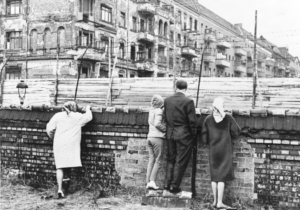
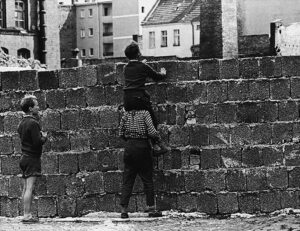 of an agreement reached between East and West Berlin. Eventually, over 170,000 passes were issued to West Berlin citizens, each pass allowing a one-day visit to communist East Berlin. Of course, there would be no passes for East German citizens to visit the west. The government knew they would not come back.
of an agreement reached between East and West Berlin. Eventually, over 170,000 passes were issued to West Berlin citizens, each pass allowing a one-day visit to communist East Berlin. Of course, there would be no passes for East German citizens to visit the west. The government knew they would not come back.
The day was marketed as a “wonderful government” doing some kind of a great thing. There were also moments of poignancy and propaganda. The reunions who were filled with tears, laughter, and other outpourings of emotions as mothers and fathers, sons and daughters finally met again. They were grateful, if only for a short time. The tensions of the Cold War were ever close by.
As people crossed through the checkpoints, loudspeakers in East Berlin greeted them. They were told that they were now in “the capital of the German Democratic Republic,” a political division that most West Germans refused to accept. The propaganda continued as each visitor was given a brochure that explained that the wall was built to “protect our borders against the hostile attacks of the imperialists.” They were told that decadent western culture, including “Western movies” and “gangster stories,” were flooding into East Germany before the wall sealed off such dangerous trends. The picture they were painting was of the East German government being the “saviors of the morality” of the people.
The West Berliners weren’t terribly happy either and many newspapers charged that the visitors charging that they were just pawns of East German government propaganda. It was said that the whole thing was a ploy to 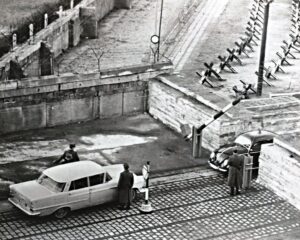
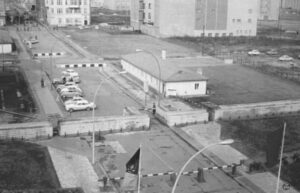 gain West German acceptance of a permanent division of Germany. Whatever the case may be, the visitors felt that they had no choice to comply with the rules, because their hearts were being torn out by these separations. The separation continued until President Reagan called for the wall to be torn down in a speech in West Berlin on June 12, 1987…almost 26 years after it was built.
gain West German acceptance of a permanent division of Germany. Whatever the case may be, the visitors felt that they had no choice to comply with the rules, because their hearts were being torn out by these separations. The separation continued until President Reagan called for the wall to be torn down in a speech in West Berlin on June 12, 1987…almost 26 years after it was built.
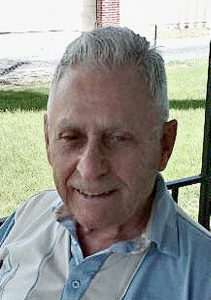
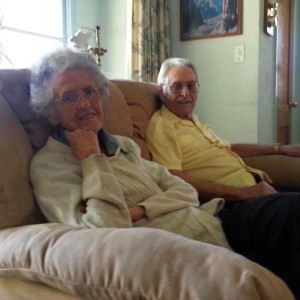 When a couple has daughters, it naturally follows that when those girls reach dating age, the house will be filled with young gentlemen callers. My grandparents, George and Hattie Byer had seven daughters, and two sons…so you can imagine that as time went on, a long line of gentlemen callers went in and out of their home. The first young man to transition from being a gentleman caller to being part of the family was George Hushman, who became Uncle George when he married my Aunt Evelyn (Byer) Hushman. Of course, he wasn’t uncle then, nor was she aunt, because they would be the couple to start the
When a couple has daughters, it naturally follows that when those girls reach dating age, the house will be filled with young gentlemen callers. My grandparents, George and Hattie Byer had seven daughters, and two sons…so you can imagine that as time went on, a long line of gentlemen callers went in and out of their home. The first young man to transition from being a gentleman caller to being part of the family was George Hushman, who became Uncle George when he married my Aunt Evelyn (Byer) Hushman. Of course, he wasn’t uncle then, nor was she aunt, because they would be the couple to start the 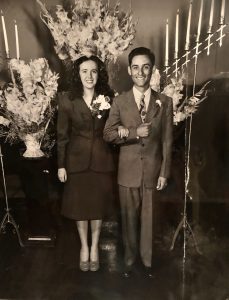 procession of grandchildren who would bless the lives of my grandparents and continue to grow even after their passing.
procession of grandchildren who would bless the lives of my grandparents and continue to grow even after their passing.
Uncle George won Aunt Evelyn’s heart pretty quickly, because when he saw her…well, he couldn’t see any other girl again. It was pretty much love at first sight, and that feeling never left them. They could be in a crowded mall, but as far as they were concerned, they were the only ones in the place. Their happy marriage brought them five beautiful children, Sheila (Susie) Young, George Hushman Jr, Shelley Campbell, Shannon Limmer, and Greg Hushman, as well as a number of grandchildren, great grandchildren and great great grandchildren. Yes, they were very blessed throughout the years. And, as the Byer siblings married and had children, they got to be aunt and uncle to many nieces and nephews too, making them finally the aunt and uncle I knew from birth.
The had many hobbies, including their beautiful yard and home, bowling, traveling, and in their early 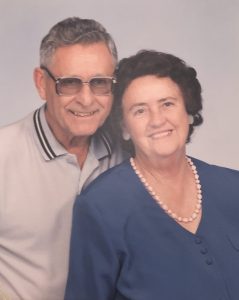
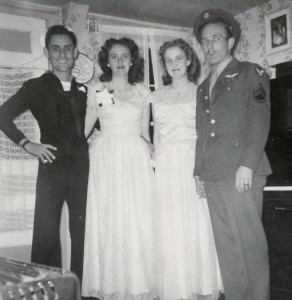 marriage…double dates with my parents, Al and Collene (Byer) Spencer. The two couples were great friends right away and loved spending time together. The Hushman kids and the Spencer girls were often together in those young days. Uncle George and Aunt Evelyn lived long lives too. She passed away on May 4, 2015, at the age of 86, and he passed on December 21, 2018, at the age of 92. Their lives were blessed and happy, and really all they ever wanted to do was to be together. Today would have been Uncle George’s 96 birthday. Happy birthday in Heaven, Uncle George. We love and miss you very much.
marriage…double dates with my parents, Al and Collene (Byer) Spencer. The two couples were great friends right away and loved spending time together. The Hushman kids and the Spencer girls were often together in those young days. Uncle George and Aunt Evelyn lived long lives too. She passed away on May 4, 2015, at the age of 86, and he passed on December 21, 2018, at the age of 92. Their lives were blessed and happy, and really all they ever wanted to do was to be together. Today would have been Uncle George’s 96 birthday. Happy birthday in Heaven, Uncle George. We love and miss you very much.

 My niece, Michelle Miller has had a very busy year. Michelle has been an art educator for the Nicolaysen Art Museum. It was a different kind of teaching than Michelle expected to be doing, but it has been very rewarding, and she has found it to be a surprise blessing. Michell loves teaching, and loves introducing her students to a whole new world…one that is filled with beauty and expression. Many of these kids have never really been exposed to the beauty of art, and Michelle loves to be the one to show it to them.
My niece, Michelle Miller has had a very busy year. Michelle has been an art educator for the Nicolaysen Art Museum. It was a different kind of teaching than Michelle expected to be doing, but it has been very rewarding, and she has found it to be a surprise blessing. Michell loves teaching, and loves introducing her students to a whole new world…one that is filled with beauty and expression. Many of these kids have never really been exposed to the beauty of art, and Michelle loves to be the one to show it to them.
Michelle is so well liked by everyone, and that has put her in the position of being promoted quickly. Michelle is now the Curator of Education, which means that while she held on to a couple of classed for herself, she is mainly over the other teachers and the education program in general. It is a lot of responsibility, but Michelle is definitely up for the  task. She is a very social person, who works easily with others, but that isn’t all she has going for her. Michelle is very smart, and she can handle anything she is assigned. Never has that been more important that now, because since October, Michelle has been the Interim Director of The Nicolaysen Art Museum. That was when the last Director took another position in Tulsa, Oklahoma. Of course, Michelle could have taken over as the new Director, but her heart is in teaching. Nevertheless, until the Director they just hired takes over, Michelle is still carrying the load of that position too. As Director, Michelle was able to go to the Mountain-Plains Museum Association Convention in Tulsa from October 4th to the 7th. It was cool for her to be able to go, and she learned a lot. Michelle has also been on the board of the Wyoming Art Education Association. So, she has
task. She is a very social person, who works easily with others, but that isn’t all she has going for her. Michelle is very smart, and she can handle anything she is assigned. Never has that been more important that now, because since October, Michelle has been the Interim Director of The Nicolaysen Art Museum. That was when the last Director took another position in Tulsa, Oklahoma. Of course, Michelle could have taken over as the new Director, but her heart is in teaching. Nevertheless, until the Director they just hired takes over, Michelle is still carrying the load of that position too. As Director, Michelle was able to go to the Mountain-Plains Museum Association Convention in Tulsa from October 4th to the 7th. It was cool for her to be able to go, and she learned a lot. Michelle has also been on the board of the Wyoming Art Education Association. So, she has 
 additional responsibilities with them. While these positions are a big load, I know that Michelle is well able to handle it, and we are all so very proud of her.
additional responsibilities with them. While these positions are a big load, I know that Michelle is well able to handle it, and we are all so very proud of her.
On a non-working note, Michelle became and aunt again this past summer, when her niece Maya Stevens was born. Michelle and her husband, Matt Miller both love their nieces and nephew, and so getting a new one is very special. Maya is little sister to her sister, Elliott Stevens. Michelle also has bonus niece Brooklyn Killinger and bonus nephew, Jaxon Killinger. All in all, it has been a busy year, but as usual, Michelle has taken it all in stride and looks forward to what the new year will bring. Today is Michelle’s birthday. Hapy birthday Michelle!! Have a great day!! We love you!!
 On the day of her birth, December 19, 2020, my grandniece, Hallie Joy Moore also went to Heaven to live with Jesus. We know that Hallie is so very happy with Jesus, and she is also very proud of her parents, Lindsay and Shannon Moore, and her big sister, Mackenzie Moore, who have continued to celebrate her special day for what it is…a celebration of her life. Hallie’s name was chosen for her with much love and happiness in mind. Her name Hallie means “Praise the Lord” and Joy, of course, means “happiness.” That is how her loving parents have chosen to remember their daughter’s birthday, and we are all very proud of them for it. They have named this special day “Happy Hallie Day” and they want to “invite you to celebrate her, by reflecting on your previous year and praising the Lord for all the GOOD He has done in your life – big things, small things and everything in between!” So, that is what we will do. Happy 2nd birthday in Heaven, Hallie!! Have a wonderful celebration with Jesus and your grandparents!! We love you so much!! Happy Hallie Day II.
On the day of her birth, December 19, 2020, my grandniece, Hallie Joy Moore also went to Heaven to live with Jesus. We know that Hallie is so very happy with Jesus, and she is also very proud of her parents, Lindsay and Shannon Moore, and her big sister, Mackenzie Moore, who have continued to celebrate her special day for what it is…a celebration of her life. Hallie’s name was chosen for her with much love and happiness in mind. Her name Hallie means “Praise the Lord” and Joy, of course, means “happiness.” That is how her loving parents have chosen to remember their daughter’s birthday, and we are all very proud of them for it. They have named this special day “Happy Hallie Day” and they want to “invite you to celebrate her, by reflecting on your previous year and praising the Lord for all the GOOD He has done in your life – big things, small things and everything in between!” So, that is what we will do. Happy 2nd birthday in Heaven, Hallie!! Have a wonderful celebration with Jesus and your grandparents!! We love you so much!! Happy Hallie Day II.
 In what reality is an “invisible” army a thing…much less important? Well, the answer is…in World War II. During that war, in which battles were being fought against multiple enemy nations, of multiple fronts, the British needed a little unusual help with the different fronts. In actuality, no British Fourth Army ever took the field. That didn’t mean that they weren’t very effective in their work. but they existed as part of the deception plans Operation Cockade and the later Operation Fortitude North. During these operations, the Germans were encouraged to believe that a Fourth Army had been established with its headquarters in Edinburgh Castle, and that it was preparing to invade Norway. Britain’s “Fourth Army” was successful in drawing and keeping the German units away from the real invasion zone in Normandy. Then, in the subsequent ‘Fortitude South’ the Fourth Army with different units was presented as part of the fictitious First United States Army Group (FUSAG) in its threat to the Pas de Calais.
In what reality is an “invisible” army a thing…much less important? Well, the answer is…in World War II. During that war, in which battles were being fought against multiple enemy nations, of multiple fronts, the British needed a little unusual help with the different fronts. In actuality, no British Fourth Army ever took the field. That didn’t mean that they weren’t very effective in their work. but they existed as part of the deception plans Operation Cockade and the later Operation Fortitude North. During these operations, the Germans were encouraged to believe that a Fourth Army had been established with its headquarters in Edinburgh Castle, and that it was preparing to invade Norway. Britain’s “Fourth Army” was successful in drawing and keeping the German units away from the real invasion zone in Normandy. Then, in the subsequent ‘Fortitude South’ the Fourth Army with different units was presented as part of the fictitious First United States Army Group (FUSAG) in its threat to the Pas de Calais.
The Fourth Army was always a “fictitious field army.” It first came into being as part of the British Expeditionary Force during the World War I. It was actually formed on February 5, 1916, under the command of General Sir Henry Rawlinson. The plan was for this fictitious army to carry out the main British contribution to the Battle of 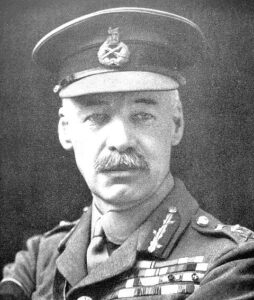 the Somme, but they quickly saw how effective a rumor could be in a war situation, and that is truly what this was. Basically, the word is sent out that a huge army is blocking a front that the enemy is trying to reach, or that they are planning to attack the enemy on a different front. So, the enemy decides to take another route…often a longer route, or in response to the rumored attack, the enemy sends it troops to the wrong place all together…only to find out they have been duped.
the Somme, but they quickly saw how effective a rumor could be in a war situation, and that is truly what this was. Basically, the word is sent out that a huge army is blocking a front that the enemy is trying to reach, or that they are planning to attack the enemy on a different front. So, the enemy decides to take another route…often a longer route, or in response to the rumored attack, the enemy sends it troops to the wrong place all together…only to find out they have been duped.
It must have been awful to take the troops into what is expected to be a battle, only to find out that they had been fooled. Imagine how that would make you look to your troops. The intel was completely false, and they fell for it. That must have made they feel very stupid on top of the fact that they wasted a lot of time on an imaginary enemy. While the Germans, in this case, looked incredibly stupid, it made the British Army look quite wise. Who would have thought that “make believe” could be such an effective weapon of warfare?
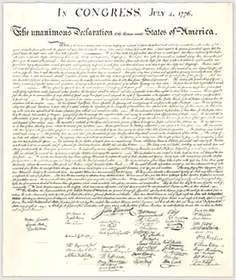
 When a country is fighting for recognition, one of the most important events is when other countries recognize your country as being an independent nation. It’s rather hard to conduct business with other nations, if you are viewed as a rouge or non-existent nation. That was the position the United States found themselves in right after the Declaration of Independence was adopted. Just because a country adopts its declaration of independence, doesn’t mean that it’s a done deal. That document can and has been the cause of major wars. The United States was no exception on the war end of that either. They fought long and hard to win that declared independence from Great Britain.
When a country is fighting for recognition, one of the most important events is when other countries recognize your country as being an independent nation. It’s rather hard to conduct business with other nations, if you are viewed as a rouge or non-existent nation. That was the position the United States found themselves in right after the Declaration of Independence was adopted. Just because a country adopts its declaration of independence, doesn’t mean that it’s a done deal. That document can and has been the cause of major wars. The United States was no exception on the war end of that either. They fought long and hard to win that declared independence from Great Britain.
Finally, the coveted recognition came when on December 17, 1777, the French foreign minister, Charles Gravier, count of Vergennes, officially acknowledged the United States as an independent nation. It came after news of the Continental Army’s overwhelming victory against the British General John Burgoyne at Saratoga. The victory gave Benjamin Franklin new leverage in his efforts to rally French support for the American rebels. Although the victory occurred in October, news did not reach France until December 4th. Remember that this mail system was worse than “snail mail” ever was. Messages had to be sent by ship across the ocean.
Benjamin Franklin had quickly mustered French support upon his arrival in December 1776. France’s humiliating loss of North America to the British in the Seven Years’ War made the French eager to see an American victory. Still, the French king worried about the consequences of backing “the rebels” openly. You can’t really blame him because an act like that could bring war to his own country. Still, he did back them in every other way. In May 1776, Louis XVI sent unofficial aid to the Continental forces and the playwright Pierre-Augustin Caron de Beaumarchais helped Franklin organize private assistance for the American cause.
Benjamin Franklin, who often wore a fur cap, captured the imagination of Parisians as an American man of nature and his well-known social charms stirred French passions for all things American. His personality made him the toast of Parisian society. He was very knowledgeable, and he had a way of enchanting groups of people 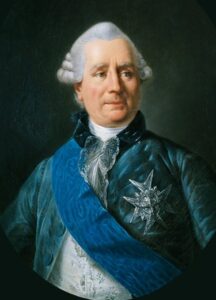
 with his wide-ranging knowledge, social graces, and witty conversation. Nevertheless, he was not allowed to appear at court, so any legal assistance he might have offered in the defense of the United States, was never heard.
with his wide-ranging knowledge, social graces, and witty conversation. Nevertheless, he was not allowed to appear at court, so any legal assistance he might have offered in the defense of the United States, was never heard.
Finally, with the impressive and long-awaited rebel victory at Saratoga, Louis XVI was convinced that the American rebels had some hope of defeating the British empire. His enthusiasm for the victory paired with French Foreign Minister Gravier’s concern that the loss of Philadelphia to the British would lead Congress to surrender, gave Franklin two influential allies with two powerful, albeit opposing reasons for officially backing the American cause, and so it was that a formal treaty of alliance with the United States followed on February 6, 1778.
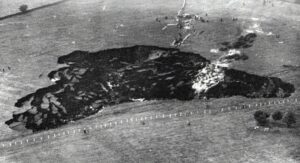 Underground mining always has the potential to become deadly. The people of New Cumnock in Ayrshire, Scotland know that all too well after a mine collapsed, trapped 120 miners underground in Knockshinnoch Castle colliery. The tragic event became known as the Knockshinnoch disaster and it occurred in September 1950 in the village of New Cumnock, Ayrshire, Scotland. The disaster began when a glaciated lake filled with liquid peat and moss flooded the pit workings, trapping more than a hundred miners underground. That set of a rescue effort that lasted for several days. Teams worked non-stop to reach the trapped men. They did finally reach the men, but by the time they were able to reach them, three days later, thirteen men had died.
Underground mining always has the potential to become deadly. The people of New Cumnock in Ayrshire, Scotland know that all too well after a mine collapsed, trapped 120 miners underground in Knockshinnoch Castle colliery. The tragic event became known as the Knockshinnoch disaster and it occurred in September 1950 in the village of New Cumnock, Ayrshire, Scotland. The disaster began when a glaciated lake filled with liquid peat and moss flooded the pit workings, trapping more than a hundred miners underground. That set of a rescue effort that lasted for several days. Teams worked non-stop to reach the trapped men. They did finally reach the men, but by the time they were able to reach them, three days later, thirteen men had died.
The men who survived were all found together 24 hours after the disaster began, and the thirteen men who died had been separated from the main group. They were missing for two more days before they were finally found. When the lake flooded, it released a field about the size of a football field into the mine. The resulting crater was about 300 feet by 200 feet and about 50 feet deep. The crater then sent liquid peat cascading into the mine, effectively blocking any exit for the men.
Thankfully, the mine owners had the forethought to install a phone in the mine, and the miners were able to phone for help. There was no way of reaching them, but the rescuers knew they were still alive, so the rescue efforts began in earnest. Rescue workers decided the easiest way to get them out was through an abandoned mine, next door. It took until 10:30pm local time for the rescuers to clear a passage through the unused mine and break through the final 30-foot wall of coal and rock that separated the two collieries. The rescue team,  made up of hundreds of miners, firefighters, and trained rescuers, worked all day to shore up the walls and ceiling of the old mine. Because the tunnels were so cramped, the workers had to work in shifts, using fans to disperse the gas known as firedamp which accumulates in sealed mines. Firedamp is not poisonous, but it reduces the amount of oxygen in the atmosphere making breathing difficult, not to mention the fact that it is also highly flammable. At one point, a rescue worker collapsed because the air was so foul. He had to be helped to the surface. The situation was really getting serious, and time was running out. The danger of explosion meant the rescuers had to use hand tools to cut through the rock delaying the rescue even more.
made up of hundreds of miners, firefighters, and trained rescuers, worked all day to shore up the walls and ceiling of the old mine. Because the tunnels were so cramped, the workers had to work in shifts, using fans to disperse the gas known as firedamp which accumulates in sealed mines. Firedamp is not poisonous, but it reduces the amount of oxygen in the atmosphere making breathing difficult, not to mention the fact that it is also highly flammable. At one point, a rescue worker collapsed because the air was so foul. He had to be helped to the surface. The situation was really getting serious, and time was running out. The danger of explosion meant the rescuers had to use hand tools to cut through the rock delaying the rescue even more.
Everyone was very focused on saving the trapped men. The volunteers were working above ground, filling the crater made by the landslide with haystacks, trees and other materials to prevent any further slippage. They knew that is more peat fell into the hole, it could have blocked what little ventilation the trapped men had. The buried miners kept in phone contact every 15 minutes or so. They were told how they could help the rescue operation by digging carefully and slowly, so as not to let in a sudden rush of foul air from the unused pit, because they had no oxygen masks to help them breathe.
Finally, the wall was breached. To let the family and friends of the trapped men know that their loved ones were safe, a siren was sounded on the surface. Immediately, huge crowds gathered near the pithead. The police linked arms to form a protective cordon around the exit. The last thing the men needed was a rush of people the minute they reached the surface. Shortly before midnight, rescuers began taking food and drink into the pit for the miners. They had been underground for so long without nutrition and hydration. While the rescuers 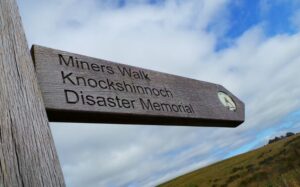
 were now with the men, the process of bringing them out of the mine would not be a speedy one. The rescue tunnel was only wide enough for one man to crawl through at a time, and many are said to be weak, so they waited while they ate and drank some water, before beginning the trek out. The Area Manager of the National Coal Board David McArdle has described the rescue operation as the greatest in the history of Scottish mining.
were now with the men, the process of bringing them out of the mine would not be a speedy one. The rescue tunnel was only wide enough for one man to crawl through at a time, and many are said to be weak, so they waited while they ate and drank some water, before beginning the trek out. The Area Manager of the National Coal Board David McArdle has described the rescue operation as the greatest in the history of Scottish mining.
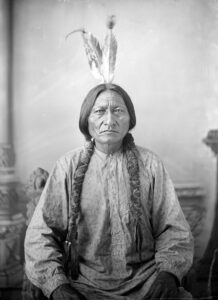 Sitting Bull was a Hunkpapa Lakota leader who led his people during years of resistance against United States government policies. The Hunkpapa Lakota is a branch of the Sioux tribe. Sitting Bull was a rather charismatic person, and people were willing to follow him because of it. He was a rather mysterious historical figure. He was not impulsive, nor was he calm. Sitting Bull had a strange personality. He was most serious when he seemed to be joking. He also possessed the power of sarcasm, and he used it to his advantage. These things are likely what made him a good leader for his people.
Sitting Bull was a Hunkpapa Lakota leader who led his people during years of resistance against United States government policies. The Hunkpapa Lakota is a branch of the Sioux tribe. Sitting Bull was a rather charismatic person, and people were willing to follow him because of it. He was a rather mysterious historical figure. He was not impulsive, nor was he calm. Sitting Bull had a strange personality. He was most serious when he seemed to be joking. He also possessed the power of sarcasm, and he used it to his advantage. These things are likely what made him a good leader for his people.
Sitting Bull was a man given to having visions, and before the Battle of the Little Bighorn, he had a vision in which he saw many soldiers, “as thick as grasshoppers,” falling upside down into the Lakota camp. The Hunkpapa Lakota people took the vision as a sign of a major victory in which many soldiers would be killed…and maybe it was. Just three weeks later, on June 25, 1876, the confederated Lakota tribes, along with the Northern Cheyenne tribe, defeated the 7th Cavalry under Lieutenant Colonel George Armstrong Custer, decimating Custer’s battalion. The battle and it’s timing seemed to bear out Sitting Bull’s prophetic vision. Again, Sitting Bull’s leadership inspired his people to 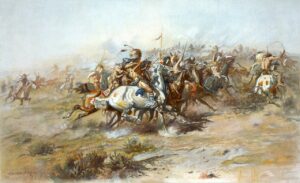 a major victory.
a major victory.
Of course, the United States government immediately sent thousands more soldiers to the area, in response to the battle. Any Indians who were in small groups or alone were a target, as were villages of peaceful Indians. Many were forced to surrender over the next year, but Sitting Bull refused to. In May 1877, he led his band north to Wood Mountain, North-West Territories, which is now Saskatchewan. Canada. Sitting Bull stayed in that area until 1881, at which time he and most of his band returned to US territory and surrendered to US forces.
Sitting Bull’s charismatic personality helped him out again when he went to work as a performer with Buffalo 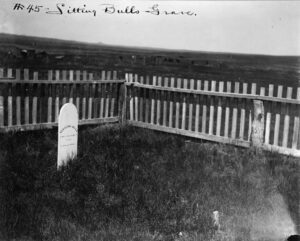 Bill’s Wild West show for a while, before returning to the Standing Rock Agency in South Dakota. That became one of the biggest mistakes Sitting Bull would ever make. Due to fears that he would use his influence to support the Ghost Dance movement, Indian Service agent James McLaughlin at Fort Yates ordered his arrest on December 15, 1890. Sitting Bull’s followers refused to go quietly, and in the struggle with police, Sitting Bull was shot in the side and head by Standing Rock policemen Lieutenant Bull Head and Red Tomahawk. His body was taken to nearby Fort Yates for burial. In 1953, his Lakota family exhumed what were believed to be his remains, reburying them near Mobridge, South Dakota, near his birthplace.
Bill’s Wild West show for a while, before returning to the Standing Rock Agency in South Dakota. That became one of the biggest mistakes Sitting Bull would ever make. Due to fears that he would use his influence to support the Ghost Dance movement, Indian Service agent James McLaughlin at Fort Yates ordered his arrest on December 15, 1890. Sitting Bull’s followers refused to go quietly, and in the struggle with police, Sitting Bull was shot in the side and head by Standing Rock policemen Lieutenant Bull Head and Red Tomahawk. His body was taken to nearby Fort Yates for burial. In 1953, his Lakota family exhumed what were believed to be his remains, reburying them near Mobridge, South Dakota, near his birthplace.

